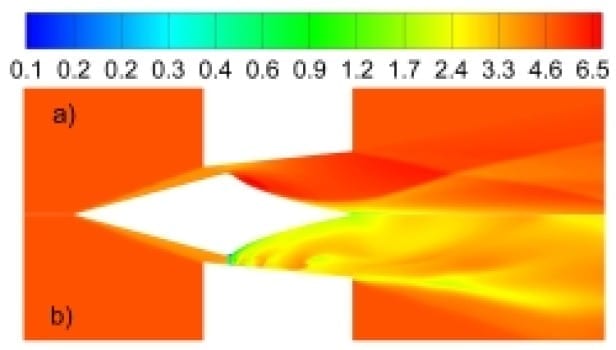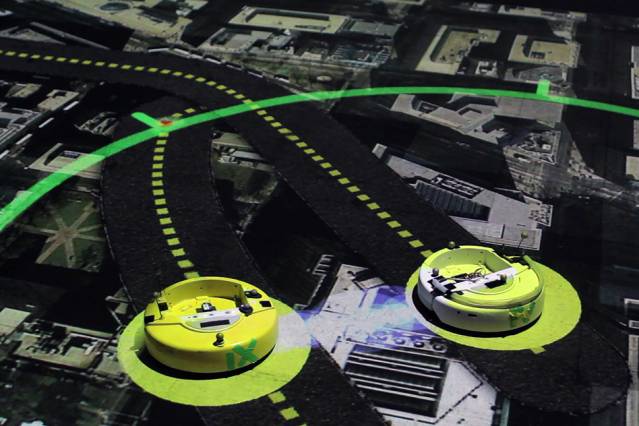
Credit: Y.Rezunkov/IOIE
New hybrid approach may help power rockets, launch satellites, enable future aircraft to exceed Mach 10
Scientists and science fiction writers alike have dreamt of aircrafts that are propelled by beams of light rather than conventional fuels. Now, a new method for improving the thrust generated by such laser-propulsion systems may bring them one step closer to practical use.
The method, developed by physicists Yuri Rezunkov of the Institute of Optoelectronic Instrument Engineering, Russia and Alexander Schmidt of the Ioffe Physical Technical Institute in Saint Petersburg, Russia is described today in The Optical Society’s (OSA) journal Applied Optics.
Currently, the maximum speed of a spacecraft is limited by the amount of solid or liquid fuel that it can carry. Achieving higher speeds means that more fuel must be burned—fuel that, inconveniently, has to be carried by the craft and hefted into space. These burdensome loads can be reduced, however, if a laser—one located at a remote location, and not actually on the spacecraft—were used to provide additional propulsive force.
A number of systems have been proposed that can produce such laser propulsion. One of the most promising involves a process called laser ablation, in which a pulsed laser beam strikes a surface, heats it up, and burns off material to create what is known as a plasma plume—a column of charged particles that flow off the surface. The outflowing of that plasma plume—essentially, exhaust—generates additional thrust to propel the craft.
In their Applied Optics paper, Rezunkov and Schmidt describe a new system that integrates a laser-ablation propulsion system with the gas blasting nozzles of a spacecraft. Combining the two systems, the researchers found, can increase the speed of the gas flow out of the system to supersonic speeds while reducing the amount of burned fuel.
The Latest on: Supersonic Laser-Propelled Rockets
[google_news title=”” keyword=”Supersonic Laser-Propelled Rockets” num_posts=”10″ blurb_length=”0″ show_thumb=”left”]
via Google News
The Latest on: Supersonic Laser-Propelled Rockets
- China’s plan to laser power supersonic submarines not feasible: Experton April 29, 2024 at 3:23 am
Expert in laser propulsion points out that Chinese tech for supersonic submarines will take away stealth making them ineffective.
- Star-powered Rockets blast past Lampsas into second roundon April 25, 2024 at 5:00 pm
No worries. Robinson sparkled with a multitude of stars at ground level. The Rockets’ high-octane boosters caught fire, as standouts Kaygen Marshall, Lexi Rosillo and Raelynn Van Zee made ...
- The Army Has Officially Deployed Laser Weapons Overseas to Combat Enemy Droneson April 24, 2024 at 5:03 pm
A pair of laser weapons has been deployed by the Army to an undisclosed location overseas to blast incoming enemy drones out of the sky.
- New laser propulsion could power silent yet supersonic Chinese submarineson April 22, 2024 at 6:52 am
A new laser-based propulsion technique developed by researchers at the Harbin Engineering University in China could help the People’s Liberation Army (PLA) build silent yet superfast submarines in the ...
- Dark is building a rocket-powered boxing glove to push debris out of orbiton April 17, 2024 at 12:50 pm
The three-year-old startup is developing Interceptor, a spacecraft that is essentially a rocket-powered boxing glove that can be launched on short order to gently punch a wayward object out of its ...
- Rocket Lab to launch NASA's new solar sail technology no earlier than April 24on April 14, 2024 at 5:00 pm
chemically propelled rockets. When particles of light called photons strike a solar sail, they transfer their momentum to that sail. Although slight, such subtle pushes are consistent and can help ...
- This insanely fast rocket-powered drone can almost reach Mach 1on April 14, 2024 at 10:05 am
The drone is able to reach these milestones thanks to a new “rotating detonation rocket engine” or RDRE attached to it. The hope is to one day attach these engines to commercial jets ...
- Laser-powered licence plates could help avoid satellite collisionson April 2, 2024 at 4:59 pm
Equipping satellites with laser-activated licence plates could help ... such as when they have just been launched on the same rocket. Receive a weekly dose of discovery in your inbox!
- AV-8B Harrier IIon March 2, 2024 at 8:44 am
4x LAU-5003 rocket pods; 4x AIM-9 Sidewinder; 6x AIM-120 AMRAAM; 6x AGM-65 Maverick; 2x AGM-84 Harpoon; 2x AGM-88 HARM; Mark 80 bombs; Paveway laser-guided bombs; Joint Direct Attack Munitions ...
- Human-Powered Laser Gun Makes Battery-Free Target Practiceon April 25, 2020 at 10:29 pm
This is what led [Dirk] to create human-powered, battery-free laser guns with software to track and display hits. In the image above, red laser hits on the target are detected and displayed on the ...
via Bing News









